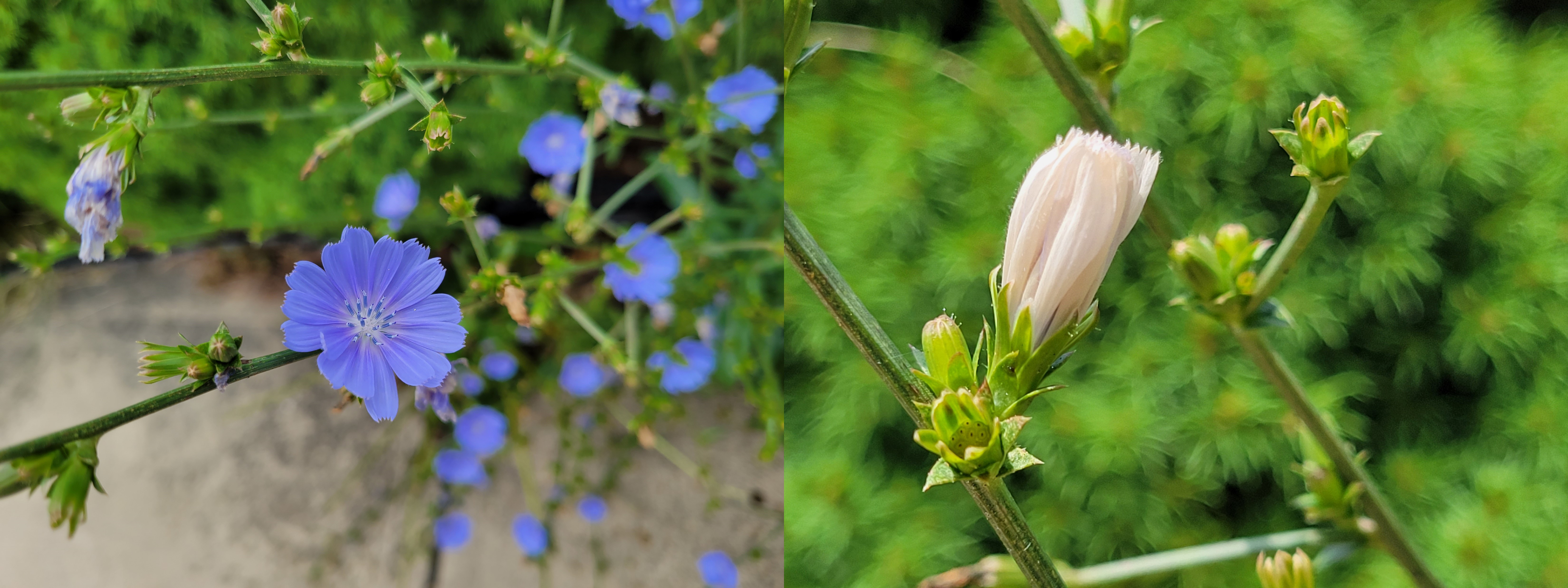Blog

#bioPGH Blog: Chicory, Dickory, Dock – The Flowers are on the Clock
 A resource of Biophilia: Pittsburgh, #bioPGH is a weekly blog and social media series that aims to encourage both children and adults to reconnect with nature and enjoy what each of our distinctive seasons has to offer.
A resource of Biophilia: Pittsburgh, #bioPGH is a weekly blog and social media series that aims to encourage both children and adults to reconnect with nature and enjoy what each of our distinctive seasons has to offer.
These flowers are on the clock
In mornings, they’re blue
By midday, they’re through,
Keeping transpiration on lock.
During high summer, have you ever noticed that chicory flowers are so beautiful, blue, and vibrant…but mainly in the morning? A notable feature of chicory is the opening and closing of their short-lived flowers. I took the photos of the same plant below at my house – one around 7:45 in the morning and the other a little after noon. In the morning, the flowers were in full bloom, but by midday day, the blooms were already done.

Though we may often take flowering for granted, a plant’s flowering time and flowering duration are based on a complex combination of factors such as the energetic demands to create a flower in the first place and the need for pollination. Beyond that, the duration of daily and seasonal bloom time is influenced by how available pollinators usually are, what time those pollinators are usually active (e.g. day or night, morning or midday), what resources go into each flower, and how long per day is the flower open. Chicory produce flowers all summer — from shortly after spring’s last frost all the way until autumn’s first frost. But throughout those seasons, they reserve daily bloom time for when their pollinators are the most active and they risk the fewest resource losses, like florivory (flowers being eaten) and water loss through their flowers. Thus, in the summer time, chicory are most likely to bloom in the morning and end flowering by midday. This protects the plant from water loss while still giving it time to be pollinated. And on cooler or overcast days, chicory may stay in bloom throughout the day.
Outside of their unique flowering strategy, chicory are notable for being a non-native plant that was brought to the US by colonizers because virtually every part of the plant historically has a use. Different parts of chicory are used in traditional medicines, teas, as an additive to coffee, and even as salad greens. Chicory is even used agriculturally as a fodder crop to help maintain soil quality while livestock such as dairy cows graze. Chicory are also members of the Asteraceae family, meaning they have the same inflorescence “flower” that is actually made up of ray florets and disk florets like other aster family members like sunflowers, coneflowers, and dandelions.
So if you’re out and about some morning, keep an eye out for a pop of blue! If you happen to pass by the same spot later on a hot day, take note of whether or not the flowers remain. The plant is probably keeping itself water-safe!
Continue the Conversation: Share your nature discoveries with our community by posting to Twitter and Instagram with hashtag #bioPGH, and R.S.V.P. to attend our next Biophilia: Pittsburgh meeting.
Wisconsin Horticulture - Chicory, Cichorium intybus
Penn State Extension - Chicory - Weed or Flower?
Brooklyn Botanic Garden – Weed of the Month: Chicory
Ohio Perennial and Biennial Weed Guide: Chicory
Seasonal variability in flower lifespan in common chicory (Cichorium intybus L.)
Photo Credits: All photos by Maria Wheeler-Dubas

